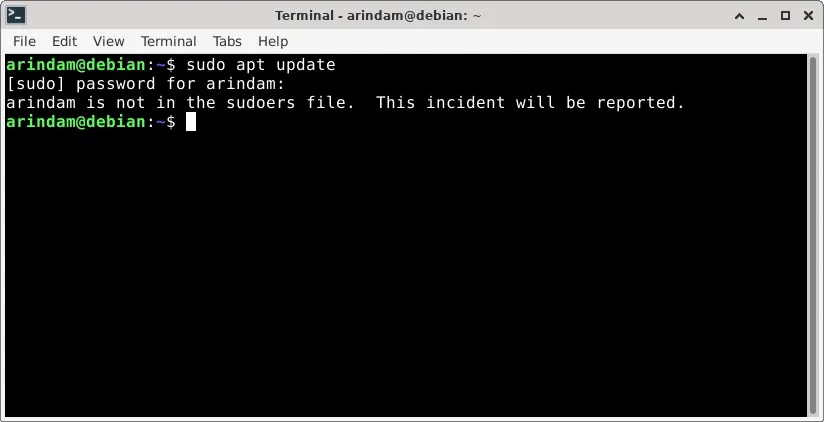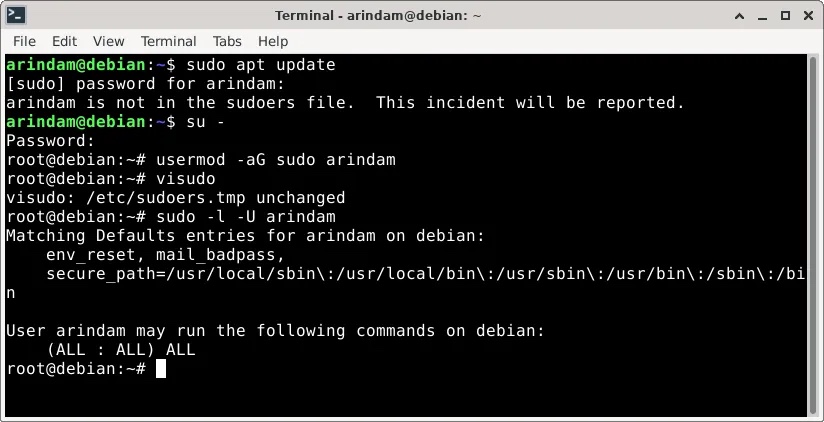2 ways to add users to SUDOERS group in Debian

The SUDOERS group plays a vital role in Debian Linux, granting administrative rights to users. Adding users to the SUDOERS group enables them to execute commands with root privileges, providing them with the necessary administrative access to perform various tasks on Debian systems.
During the installation of Debian Linux, if you leave the password of the root account blank, then the first user created in the system will have the administrative permissions. However, if you set a root password, the username will not have sudo permissions. Therefore, you may encounter errors similar to the following while using the user account to perform administrative tasks.
<username> is not in the sudoers file. This incident will be reported.
 Before adding users to the SUDOERS group
Before adding users to the SUDOERS group
This article aims to provide a step-by-step guide on adding users to the SUDOERS group in Debian to ensure that you can Effectively manage user permissions and system security.
How to add a user to the SUDOERS group in Debian
To add a user to the SUDOERS group in Debian, follow these simple steps:
- Single Click the "Terminal" icon or use the shortcut key
Ctrl Alt Tto open the terminal on the Debian system. - Switch to the root user using the following command:
su -
You will be prompted for the root password. Enter the root password and press Enter.
After logging in as the root user, enter the following command. Make sure to change it according to your username. In this example, replace arindam with your username.
/sbin/addgroup arindam sudo
If the above command does not work, you can also use the following command:
usermod -aG sudo arindam
Press Exit to leave the root prompt. Log out and log back in. Now you can perform any administrative operations using your username.
Another method
You can use the same command as below to get into the root account. Log in with root account:
su -
Then use nano or visudo or any editor to open the /etc/sudoers file.
nano /etc/sudoers
Add the following lines and username. Replace arindam with your username.
arindamALL=(ALL)ALL
Save and close the file. Then, log out and log back in. This should give the username root access.
Verify SUDOERS Group Membership
To verify that the user has been successfully added to the SUDOERS group, you can open a new terminal window and enter the following command. Replace arindam with the actual username of the user you added to the SUDOERS group.
sudo -l -U arindam
When a user belongs to the SUDOERS group, you can view their permission list. Here is an example, you can see my username has all access rights.
 After Granting Permissions
After Granting Permissions
Conclusion
Adding users to the SUDOERS group will grant them important administrative rights. Careful consideration of the user's trustworthiness and responsibility is critical before providing such access to the user. Improper use of sudo can cause unexpected damage or damage to your system.
Remember to use caution when delegating administrative rights and regularly check user permissions to maintain a secure Debian system.
The above is the detailed content of 2 ways to add users to SUDOERS group in Debian. For more information, please follow other related articles on the PHP Chinese website!

Hot AI Tools

Undresser.AI Undress
AI-powered app for creating realistic nude photos

AI Clothes Remover
Online AI tool for removing clothes from photos.

Undress AI Tool
Undress images for free

Clothoff.io
AI clothes remover

AI Hentai Generator
Generate AI Hentai for free.

Hot Article

Hot Tools

Notepad++7.3.1
Easy-to-use and free code editor

SublimeText3 Chinese version
Chinese version, very easy to use

Zend Studio 13.0.1
Powerful PHP integrated development environment

Dreamweaver CS6
Visual web development tools

SublimeText3 Mac version
God-level code editing software (SublimeText3)

Hot Topics
 1377
1377
 52
52
 How to open web.xml
Apr 03, 2025 am 06:51 AM
How to open web.xml
Apr 03, 2025 am 06:51 AM
To open a web.xml file, you can use the following methods: Use a text editor (such as Notepad or TextEdit) to edit commands using an integrated development environment (such as Eclipse or NetBeans) (Windows: notepad web.xml; Mac/Linux: open -a TextEdit web.xml)
 Four ways to implement multithreading in C language
Apr 03, 2025 pm 03:00 PM
Four ways to implement multithreading in C language
Apr 03, 2025 pm 03:00 PM
Multithreading in the language can greatly improve program efficiency. There are four main ways to implement multithreading in C language: Create independent processes: Create multiple independently running processes, each process has its own memory space. Pseudo-multithreading: Create multiple execution streams in a process that share the same memory space and execute alternately. Multi-threaded library: Use multi-threaded libraries such as pthreads to create and manage threads, providing rich thread operation functions. Coroutine: A lightweight multi-threaded implementation that divides tasks into small subtasks and executes them in turn.
 What is the Linux best used for?
Apr 03, 2025 am 12:11 AM
What is the Linux best used for?
Apr 03, 2025 am 12:11 AM
Linux is best used as server management, embedded systems and desktop environments. 1) In server management, Linux is used to host websites, databases, and applications, providing stability and reliability. 2) In embedded systems, Linux is widely used in smart home and automotive electronic systems because of its flexibility and stability. 3) In the desktop environment, Linux provides rich applications and efficient performance.
 How is Debian Hadoop compatibility
Apr 02, 2025 am 08:42 AM
How is Debian Hadoop compatibility
Apr 02, 2025 am 08:42 AM
DebianLinux is known for its stability and security and is widely used in server, development and desktop environments. While there is currently a lack of official instructions on direct compatibility with Debian and Hadoop, this article will guide you on how to deploy Hadoop on your Debian system. Debian system requirements: Before starting Hadoop configuration, please make sure that your Debian system meets the minimum operating requirements of Hadoop, which includes installing the necessary Java Runtime Environment (JRE) and Hadoop packages. Hadoop deployment steps: Download and unzip Hadoop: Download the Hadoop version you need from the official ApacheHadoop website and solve it
 Do I need to install an Oracle client when connecting to an Oracle database using Go?
Apr 02, 2025 pm 03:48 PM
Do I need to install an Oracle client when connecting to an Oracle database using Go?
Apr 02, 2025 pm 03:48 PM
Do I need to install an Oracle client when connecting to an Oracle database using Go? When developing in Go, connecting to Oracle databases is a common requirement...
 Unable to log in to mysql as root
Apr 08, 2025 pm 04:54 PM
Unable to log in to mysql as root
Apr 08, 2025 pm 04:54 PM
The main reasons why you cannot log in to MySQL as root are permission problems, configuration file errors, password inconsistent, socket file problems, or firewall interception. The solution includes: check whether the bind-address parameter in the configuration file is configured correctly. Check whether the root user permissions have been modified or deleted and reset. Verify that the password is accurate, including case and special characters. Check socket file permission settings and paths. Check that the firewall blocks connections to the MySQL server.
 libv are two
Apr 03, 2025 pm 08:03 PM
libv are two
Apr 03, 2025 pm 08:03 PM
I developed a project called Lua-Libuv and am happy to share my experience. The original intention of the project is to explore how to use Libuv (an asynchronous I/O library written in C) to build a simple HTTP server without having to learn the C language in depth. With the help of ChatGPT, I completed the basic code of HTTP.C. When dealing with persistent connections, I successfully implemented closing the connection and freeing resources at the right time. At first I tried to create a simple server that ended the main program by closing the connection, but I had some problems. I've tried sending blocks of data using streaming, and while it works, this blocks the main thread. In the end, I decided to give up on this approach because my goal was not to learn C language in depth. Finally, I
 C language conditional compilation: a detailed guide for beginners to practical applications
Apr 04, 2025 am 10:48 AM
C language conditional compilation: a detailed guide for beginners to practical applications
Apr 04, 2025 am 10:48 AM
C language conditional compilation is a mechanism for selectively compiling code blocks based on compile-time conditions. The introductory methods include: using #if and #else directives to select code blocks based on conditions. Commonly used conditional expressions include STDC, _WIN32 and linux. Practical case: Print different messages according to the operating system. Use different data types according to the number of digits of the system. Different header files are supported according to the compiler. Conditional compilation enhances the portability and flexibility of the code, making it adaptable to compiler, operating system, and CPU architecture changes.




